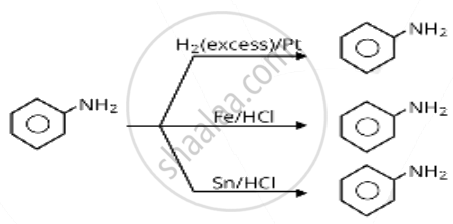Advertisements
Advertisements
Question
Which of the following reagents would not be a good choice for reducing an aryl nitro compound to an amine?
Options
\[\ce{H2 (excess)/Pt}\]
\[\ce{LiAlH4}\] in ether
\[\ce{Fe}\] and \[\ce{HCl}\]
\[\ce{Sn}\] and \[\ce{HCl}\]
Solution
\[\ce{LiAlH4}\] in ether
Explanation:
Lithium aluminium hydride in either is a strong reducing agent that donated its \[\ce{H-}\] hydride ion to any \[\ce{C = O}\] containing a functional group. In addition to \[\ce{LiAlH}\], to aryl nitro compounds, no reaction will be observed, the desired products of amines will not be produced, rather it will form diazobenzene products.

\[\ce{2C4H5NO ->[LiAlH4/ether] C6H5N = N - C6H5}\]
APPEARS IN
RELATED QUESTIONS
Write the chemical equation involved in the following reaction:
Hoffmann-bromamide degradation reaction
Mention 'two' uses of propan-2-one.
Why cannot aniline be prepared by Gabriel phthalimide synthesis?

Identify the major product (B).
Identify 'A' and 'B' in the following conversions.
\[\ce{CH3 - I ->[Alc. KCN][\Delta] A ->[Na/C2H5OH] B}\]
Which of the following compounds is the weakest Brönsted base?
Which of the following methods of preparation of amines will give same number of carbon atoms in the chain of amines as in the reactant?
Which of the following reactions are correct?
(i)

(ii)

(iii)

(iv)

Describe Gabriel's phthalimide synthesis. (Give reaction)
Write a short note on the following:
Ammonolysis
